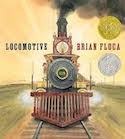
It is the summer of 1869, and trains, crews, and family are traveling together, riding America’s brand-new transcontinental railroad. These pages come alive with the details of the trip and the sounds, speed, and strength of the mighty locomotives; the work that keeps them moving; and the thrill of travel from plains to mountain to ocean.
Come hear the hiss of the steam, feel the heat of the engine, watch the landscape race by. Come ride the rails, come cross the young country!
- ISBN: 9781416994152
- Author: Floca, Brian
- Published: 2013, Atheneum Books for Young Readers
- Descriptors: Awards, Caldecott, Early Years (ages 2-6), Intermediate (ages 9-14)
- No. of pages: 64

Ray:
Locomotive is an amazing book in so many ways. My interest in this book was first peaked because the cover shows an historic locomotive engine similar to one that just came to our town in Pennsylvania. It is a replica of the train from the time of President Lincoln that came through our town back in the 1860’s. The dust jacket does not match the hard cover which you see in most picturebooks. This image on the hard cover shows buffalo roaming the plains before the first railroad came to the area. The front end papers give us a great deal of information about the building of the first transcontinental railroad. Then begins the marvelous adventure of the building of the railroad and the land it travels through seen through the wonderful art work of Brian Floca. Each double page spread is a great example of the art concept of perspective and the use of orthography (typography). Many of the type designs are examples of type used during the historic period of the building of the first railroad. This type becomes an integral part of the overall composition of each illustration.
Prisca:
I agree that this is quite a book. It’s understandable that it was the Caldecott winner this year. The research and detail are breathtaking! The front endpapers show a map of the Union Pacific (Omaha, NE) and Central Pacific (Sacramento, CA) railroads and give a brief history of their construction and meeting in Utah. The story basically begins with the completed railroad and people waiting for the train and follows their ride from Omaha to Sacramento, showing landscapes along the way and providing information on how the train worked, issues people had to deal with along the way, including eating, sleeping, and going to the bathroom. The back endpapers show a cross-section of the locomotive and how it worked. We heard Brian Floca speak at the National Book Festival in Washington, D.C., last September. Didn’t he talk about the research he did?
Ray:
Yes, I believe he said he traveled the route that was taken in building the train in preparing to write and illustrate the book. This research shows in the details of the book that make it very authentic. I had the privilege of talking with Brian’s father as I waited in line to have Brian autograph a copy of the book we had purchased. He recounted to me some of the research Brian had done. I wanted to return to the art work in the book for a moment. The points of view Brian illustrated in a number of the illustrations are a great example of perspective that an art teacher or any teacher could use in the classroom with their students. I immediately brought the book to my university classes and showed them page after page of exciting compositions that they could show their own students. The front cover alone is an example of one-point perspective. One page shows a close-up of the wheels and pistons that drive the train. In another very exciting view you are standing on the front railing of the engine next to the large lantern or light looking back at the engineer as he blows the whistle on a starry night somewhere over the American plains. You see the words and can feel the sound as the engineer blows the whistle. Two pages later you see a fantastic drawing of a train trestle illustrating two-point perspective. Towards the end of the book you take a birds-eye view of the train as it rounds a curve and begins its downhill decent at Cape Horn. Using this view of looking down helps to give you a sense of going downhill. Down, down, down goes the train to its final destination of Sacramento, California. This artistic view shows the brilliance of Brian as an artist who knows and understands the language used by visual artists to communicate this universal language of communication.
Prisca:
The massiveness of the engine really comes through in Brian’s art! As you mentioned earlier too, the way the text is written really adds to the drama of the book. Readers can almost hear the “HUFFS and HISSES” and “WHOO-OOOOO”s and CHUG-CHUG CHUG-CHUG!” of the engine as it moves along the track across the country. The descriptive and lyrical text is beautifully written also: the “wild and lonesome cry” of the whistle, the cab that is “small as a closet, hot as a kitchen”, and the steam that “pushes pushes through the pipes.” Locomotive is truly a work of art in every sense.